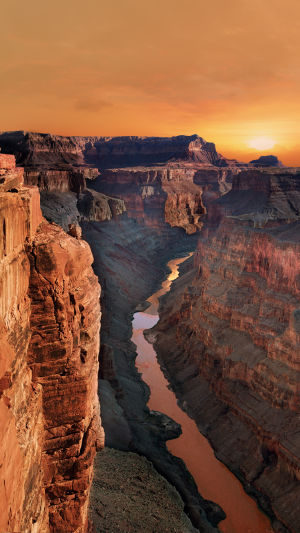The Grand Canyon in Arizona is one of the most famous natural landscapes in the United States and one of the most spectacular canyons in the world. It is located in the northern part of the Colorado Plateau and was formed by the erosion of the Colorado River over millions of years.
The length of the Grand Canyon is approximately 446 kilometers (277 miles), with a width ranging from 6 to 29 kilometers (4 to 18 miles), and a maximum depth of about 1.8 kilometers (1.1 miles). Its breathtaking scenery features steep cliffs that create stunning vistas.
The Grand Canyon can be divided into two main areas: the South Rim and the North Rim. The South Rim is the most popular and frequently visited area, housing most of the tourist facilities and viewpoints. The North Rim is relatively remote and sees fewer visitors, but it offers a more primitive wilderness experience.
Visitors can choose from various ways to explore the Grand Canyon, including hiking, biking, driving, taking helicopter tours, or riding the Grand Canyon Railway. The canyon provides numerous hiking and camping opportunities, allowing visitors to experience its magnificent natural landscapes firsthand.
Furthermore, the Grand Canyon is a region of rich biodiversity, with many unique plant and animal species. Visitors may encounter wildlife such as elk and witness the traditional dwellings and cultural sites of Native Americans during their exploration.
Beyond its status as a natural wonder, the Grand Canyon in Arizona is also an important area for geological research. Scientists have used the study of its rock layers and geological history to uncover the processes of Earth's evolution over millions of years.
In summary, the Grand Canyon in Arizona attracts global visitors with its breathtaking scenery and unique geological features. It is designated as a national park in the United States and recognized as a UNESCO World Heritage site, acknowledged as one of the most awe-inspiring natural wonders on Earth.
When photographing the Grand Canyon in Arizona, here are some useful techniques:
1. Utilize Lighting: Harnessing light is one of the most crucial factors in photography. In the Grand Canyon, the light is typically soft and beautiful during the early morning and evening hours. This time is often referred to as the "golden hour," and capturing images during this time can result in a warm and gentle lighting effect. Try to avoid photographing under harsh midday sunlight, as it can lead to overexposure or excessive shadows.
2. Size Contrast: The Grand Canyon is a vast and magnificent landscape, and to convey its scale and depth, you can try introducing some reference objects into your photos, such as people, trees, or other elements, to highlight the immense magnitude of the canyon.
3. Foreground Elements: When composing your shots, try incorporating interesting elements in the foreground, such as rocks, trees, or plants. This can add depth and layering to your photos, providing viewers with a sense of immersion.
4. Lens Selection: The Grand Canyon is a vast and grand location, and using a wide-angle lens can help capture the entire landscape. Additionally, a telephoto lens can be used to capture details or distant scenery.
5. Use a Tripod: Using a tripod is highly beneficial when capturing long exposures or when stability is required. It prevents photo blur and allows for better control of composition and details.
6. Experiment with Different Angles: Don't be afraid to try different angles and perspectives when photographing the Grand Canyon. Crouch down, look up, or attempt to position yourself in different locations to bring fresh and unique visual effects to your photos.
7. Capture Sunrise and Sunset: The sunrise and sunset moments at the Grand Canyon are some of the most beautiful. Plan your location and timing in advance, and make sure to bring enough storage space and spare batteries when photographing these breathtaking moments.
8. Focus on Details: In addition to capturing the entire landscape, you can also focus on capturing details within the Grand Canyon, such as rock textures, flowing rivers, or blooming wildflowers. These detailed shots can showcase the uniqueness of the Grand Canyon.
Most importantly, enjoy your photography experience at the Grand Canyon in Arizona. Experiment with different techniques and creative ideas to convey the beauty and charm of the magnificent landscapes





